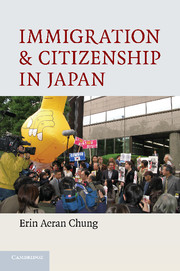Book contents
- Frontmatter
- Contents
- Tables and Figures
- Conventions and Abbreviations
- Acknowledgments
- Immigration and Citizenship in Japan
- Introduction: The Contradictions of Japan's Immigration and Citizenship Politics
- 1 Is Japan an Outlier? Cross-National Patterns of Immigrant Incorporation and Noncitizen Political Engagement
- 2 Constructing Citizenship and Noncitizenship in Postwar Japan
- 3 Negotiating Korean Identity in Japan
- 4 Citizenship as Political Strategy
- 5 Destination Japan: Global Shifts, Local Transformations
- Conclusion
- References
- Index
3 - Negotiating Korean Identity in Japan
Published online by Cambridge University Press: 03 May 2010
- Frontmatter
- Contents
- Tables and Figures
- Conventions and Abbreviations
- Acknowledgments
- Immigration and Citizenship in Japan
- Introduction: The Contradictions of Japan's Immigration and Citizenship Politics
- 1 Is Japan an Outlier? Cross-National Patterns of Immigrant Incorporation and Noncitizen Political Engagement
- 2 Constructing Citizenship and Noncitizenship in Postwar Japan
- 3 Negotiating Korean Identity in Japan
- 4 Citizenship as Political Strategy
- 5 Destination Japan: Global Shifts, Local Transformations
- Conclusion
- References
- Index
Summary
WHAT'S IN A NAME?
Discussion of Koreans in Japan – in English as well as in Japanese – often begins with the thorny issue of names. In English, this community is most often referred to as “Korean residents in Japan” (in reference to their legal status) or “ethnic Koreans in Japan” (which would include Japanese nationals of Korean ancestry), or the “Korean minority in Japan” (to signify their discursive position in Japanese society), or simply, “Koreans in Japan.” Although some use the term Korean-Japanese (or Japanese-Korean) to refer to this group, the concept of hyphenated identities has yet to be widely accepted in Japanese society. The official Japanese term for Korean residents is Zainichi Kankoku Chōsenjin (South and North Korean Residents in Japan); however, the actual term used by individuals and groups is inextricably linked to the identity politics of this community. The official term in itself divides the community according to nationality – with the implication that Chōsen refers only to North Korea – and privileges South Korean nationals by placing Kankoku before Chōsen. Although some prefer the term Zainichi Korian because of its neutrality and its apparent reference to Koreans as an ethnic group, others identify themselves according to their specific nationalities (e.g., Zainichi Kankokujin if they are South Korean nationals). Still, some prefer Chōsenjin, which was the term used to refer to Koreans prior to the war, while others simply use the abbreviation Zainichi as a reference to their permanent residence in Japan.
- Type
- Chapter
- Information
- Immigration and Citizenship in Japan , pp. 82 - 114Publisher: Cambridge University PressPrint publication year: 2010



